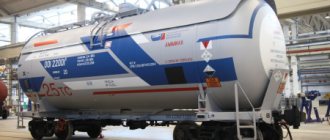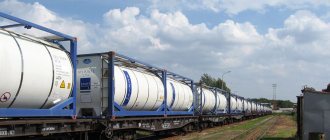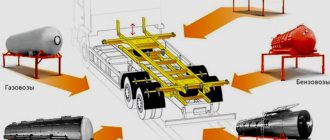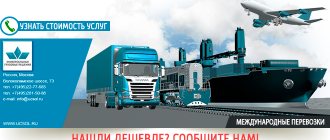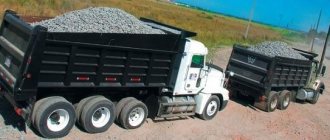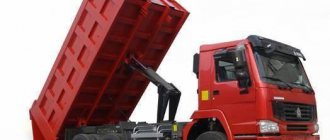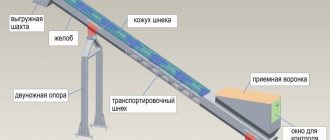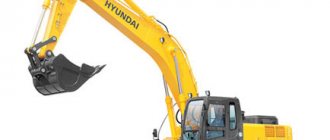Transportation of cargo by tanker trucks allows us to solve transport problems, the purpose of which is the transportation, delivery, transportation and handling of liquid cargo by road transport. Transportation of liquid and liquid cargo in tanks has a number of characteristics. The fact is that for each bulk cargo, even of the same type, separate and specially modified tanks are required. For example, crude oil and gas, or other dark and light petroleum products cannot be transported in identical tanks. The same goes for liquid food products: milk, molasses, butter, juice, etc.
Tankers design and characteristics
Application of tank trucks
The use of tank trucks and PPT semi-trailers can significantly increase the carrying capacity of rolling stock and reduce transportation costs. Currently, there are a number of modifications of tanks, specially adapted for the transportation of light and dark petroleum products, chemical and food varieties of liquid cargo. Tanker cars and road trains are proliferating, although the cost of transporting tank cars is on average slightly higher than that of conventional trucks. However, when using them, the cost of containers and packaging, maximum safety of the cargo is ensured during loading, transportation, unloading and the cost of loading and unloading operations (reducing time, eliminating manual labor).
Tanks for transporting liquid cargo are installed on the chassis of trucks, trailers and semi-trailers. In addition, tanks can be insulated, heated and cooled. For example, tanks for transporting certain materials (paraffin, soap, resin, fuel, etc.) are made heated to prevent these materials from hardening during transport. Artificially refrigerated tanks have been created for the transportation of perishable products. Tankers and fuel dispensers are manufactured on the basis of the chassis of the main models of trucks, trailers and semi-trailers. They differ only in the cargo body, made in the form of a tank, and are equipped with special equipment (compressor, pumps, crane, fittings, etc.) designed to perform the corresponding work.
Today, tank trucks are characterized by the following trends:
- Reducing dead weight (using light alloys, plastics and load-bearing structures of the road train);
- Increased tank truck capacity;
- Finalization and revision of the design;
- The productivity of equipment for filling and unloading tanks has been increased.
Tanks have a number of modifications, respectively, for inert and aggressive substances, depending on the physical conditions of a similar bulk cargo, etc. The materials from which PPTs are made also vary. Transportation of goods is carried out by tanks specially designed for certain types of goods.
Among them are the following types of tank trucks:
Chemical
Tanks for the transportation of chemical liquids (chemical tanks) are designed for the transportation of chemicals, both light and aggressive. To transport aggressive chemicals, the tank is usually made of stainless steel. Chemical tanks are made of special AISI 316 stainless steel, which belongs to the AISI 304 class, but with the addition of molybdenum to the alloy. Thanks to molybdenum, steel is especially resistant to corrosion, high temperatures and aggressive chemicals.
For the transportation of bulk chemicals, rubberized tanks are used, which are used for the transportation and temporary storage of aggressive acidic - alkaline cargo, since the internal surface is covered with mastic based on bitumen resin and a number of other protective materials, products that, due to their properties, provide reliable protection of the internal containers of the semi-trailer tank from corrosion. In addition, tanks made of composite materials such as fiberglass are used to transport acid-base substances with aggressive, corrosive properties.
Alternative option
Transportation of petroleum products is also possible using three-axle trailers that are attached to truck tractors (MAZ, URAL). This transportation option is optimal for off-road use, as they are equipped with specialized tires and additional side lighting. In addition, they are equipped with spare wheels, which ensures safety and smooth transportation.
The tank trailer package includes the following equipment:
- screw jacks placed on both sides;
- ball valves and a sump with filter elements are located on the rear;
- the platform, made of specialized steel, and complemented by flooring, is equipped with a folding fence and a ladder;
- the container is made of steel and has an elliptical shape, its volume is on average 40 m3;
- the volume of fuel is measured by level meters installed in the neck;
- two sealed hatches are located on the bottom side;
- The neck of the tank is fixed with hinged bolts and is complemented by a breathing valve designed to reduce the amount of fuel evaporated.
Food
Tanker trucks for the transportation of liquid food products (food tanks) are used for transportation, temporary storage, delivery to the point of sale and to processing points food liquids with a density of no more than 1.03 g/cm3. Edible liquid cargo includes various types, concentrate, vegetable oils, fats, syrups, molasses, chocolate, glucose, alcoholic beverages, dairy products, as well as live fish and much more.
Tanks for the transport of liquid food products must comply with European environmental standards. Before each load, carry out a special procedure of washing, steaming and treating the internal surfaces of the air conditioner container with disinfectants. For the transportation of food liquids, PPC containers are made of high-quality INOX or AISI 316L stainless steel. Food tanks have an additional isothermal insulation layer of mineral insulation to maintain the initial temperature of the transported liquid. The isothermal tank consists of corrosion-resistant stainless steel and various sections, a base and a service compartment, located at the rear or side of the tank. The tank has filler holes for filling, disinfecting and inspecting the inside of the PPT container. Each package is closed with separate thermally insulated lids. Filler and drain pipes are reliably protected from frost in winter.
What is carried in tanks
All food cargo is divided into two main categories:
- Non-perishable goods The main distinguishing feature of such goods is the ability to retain their unique qualities for a long time. Such cargo includes sugar, salt, various cereals, and canned food.
- Perishable cargo Products with a short shelf life, as well as food cargo that require special storage and transportation conditions (maintaining a certain temperature or humidity level in the container) are classified as perishable. In this case, such products can be: Of plant origin (fruits, vegetables, vegetable oil)
- Animal origin (meat, eggs, milk, fish)
- Processed products (sausages, cheeses, cottage cheese)
They transport liquid food cargo of various types:
- Milk and dairy products – cheese and whey, regular, concentrated and condensed milk.
- Food and feed additives for food production, livestock and farming.
- Juice and juice concentrate from domestic and imported raw materials.
- Vinegar and acetic acid.
- Drinking and mineral water.
- Chocolate and chocolate-based products, molasses, sugar syrups for the confectionery industry and catering establishments.
- Kvass wort and its concentrate.
- All kinds of vegetable and animal fats and oils.
- Wine and wine materials.
Fuel trucks
Tank trucks for the transportation of light petroleum products and fuels and lubricants (tank trucks) are designed for the transportation and short-term storage of light petroleum products with a density of 0.7 - 0.86 g / cm3 on public highways in conditions corresponding to their climatic characteristics. Tanker trucks are designed to transport various types of light petroleum products, fuels and lubricants (gasoline, diesel fuel, industrial oils, etc.).
Gasoline consists mainly of volatile, flammable and explosive fractions, so tanks are manufactured taking into account high fire safety requirements. tank trucks usually have several autonomous compartments that allow them to transport several types of fuel at the same time, usually the number of compartments varies from 3 to 5 pieces, but there are exceptions. Tankers are made of special steel grade 09G2S with a thickness of at least 4 mm. In addition, fuel tanks for transporting light petroleum products differ in the volume of loaded fuel and in a very wide range. Therefore, fuel trucks differ in tanker capacity, shape (suitcase, oval or round) and number of compartments. A properly selected tank shape allows you to increase the volume of transported petroleum product. The presence of separated compartments on the tanker allows you to simultaneously deliver gasoline of different brands to gas stations.
Transportation of liquid cargo by water transport
The classification of liquid cargo at sea differs from the classification used on land.
The International Convention for the Prevention of Pollution from Ships "MARPOL 73/78" divides liquid cargoes as follows:
- petroleum products;
- liquids hazardous to the water area;
- liquids that are not hazardous to the water area.
Liquid cargo loaded into tank containers or flexitanks is transported along sea routes on container ships. The largest container ships of the “Post-Triple E” class, which belong to CSCL, can transport 21,000 units. 40 foot containers. Containers can also be transported on lighter carriers; they are smaller and more maneuverable than container ships. Such a vessel can deliver cargo to unequipped or shallow-water ports.
According to the Association of Sea Trade Ports for 2022, the volume of liquid cargo transshipment in Russian ports amounted to 464.2 million tons, which is 23% more than the volume of dry cargo transshipment. Of this number, 426 million tons are oil and petroleum products (92%).
This share of petroleum products in transportation by sea is explained by the location of oil fields and the low cost of transportation.
Large volumes of liquid cargo are transported by tankers. Tankers are self-propelled cargo ships. They don't have any cargo equipment as such. Most of the vessel's volume is occupied by compartments into which the transported liquid is poured. Modern tankers are made with double walls on the bottom and sides. Double walls increase the strength of the vessel and reduce the likelihood of cargo spills. The first tankers did not have such walls, but later, with the entry into force of MARPOL 73/78 on October 2, 1973, this requirement became mandatory for newly manufactured tankers.
There are supertankers that transport more than 318 thousand tons at a time - that’s 2 million barrels of oil, as well as multi-section ones that can transport several types of cargo at a time, up to six at a time. These tankers are divided inside into special compartments that do not allow cargo to mix.
Types and classification of cargo.
Views: 13,720
Bitumen truck
Tankers for transporting dark petroleum products (tanks for bitumen conveyors, fuel oil and oil tankers) are designed for transportation and short-term storage of dark petroleum products. Dark oil products are oil, fuel oil and bitumen, which are residual products of processing or natural derivatives of coal, oil and shale. Bitumen tankers and fuel oil tankers are special vehicles. This type of tank ensures that the cargo is heated during transportation up to 250 degrees Celsius.
The design of self-bitumen conveyors of various types allows you to maintain the temperature of bitumen during its transportation, heat the tank to operating temperature, pump out, bypass the tank and remove bitumen deposits from bitumen melting pots. Heating of bitumen or fuel oil in the tank is provided by special fire tube systems running on diesel fuel or kerosene. In addition, the special design of the isothermal tank of the bitumen tank ensures low heat losses, which, together with heating systems, makes it possible to transport petroleum products over long distances. The inside of the tank is equipped with bulkheads (breakwaters) to reduce hydraulic shocks when the vehicle is braking. Attached to the breakwaters are two fire tubes that run the entire length of the tank. At the entrance to the tank, the flame tubes have an expansion with a refractory lining, forming a combustion chamber. The fuel in the tank is under pressure and is supplied to two stationary and one portable burners. The pump not only fills the tanks with bitumen, but also circulates and drains it. In the production of bitumen conveyors and all kinds of components for this special equipment, only special materials are used to ensure the safety of transporting this particular load. After all, the transportation of flammable goods, the temperature of which fluctuates within 230 degrees Celsius, is a procedure of increased danger that requires a careful approach at all stages of the transport process.
Mobile gas stations: growing in popularity
Tankers for transporting light petroleum products are increasingly being equipped with metering units that turn them into mobile filling stations. This type of special equipment is in demand today at construction sites, in the transport industry, but more often in hard-to-reach, remote places. A tank truck with a fuel and lubricants consumption metering unit can be useful for both loggers and geologists. There are even refueling modules that do not require electricity to operate. They use mechanical meters and mechanical pumps.
A large assortment of mobile gas stations is offered by Penzaspetsavtomash . The production of mobile and stationary gas stations under the Benza brand is one of the priority areas of the company’s activities. Penza engineers have achieved that the payback period of their MTZS with intensive use can be only a few months, and today it is often more profitable for a buyer to buy a Penzaspetsavtomasha mini-gas station than to install a stationary gas station. Moreover, all Penza MTZS are certified and comply with current Russian standards.
The well-known company supplies high-quality equipment for gas stations and additional equipment for tank trucks. As a dealer of the well-known company PiUsi , the company successfully sells a series of modular mini-gas stations Cube from Italy on the domestic market. The range of equipment for mobile gas stations, fuel dispensers with discharged fuel metering systems, fuel level sensors in the tank, offered by the New Technologies Group of Companies, will satisfy any potential buyer.
Gas carriers
Transport tank trucks liquefied gas CIS (gas tank trucks) Designed for transportation and short-term storage of gases, including propane, butane and their mixtures, under pressure up to 2.3 MPa and temperature from -40 to +45 °. To transport liquefied hydrocarbon gases (LPG), special tank trucks and gas tank trucks are used. Tank trucks have a special design, which has an outer shell and double ship walls. A high level of safety during the operation of gas transport tanks is achieved through the use of a double-walled tank casing in the design. The space between the walls is filled with special fire-resistant material.
LPG semi-trailers for transporting liquefied gas are divided into two types:
- Gas stations - PPCZ. Designed for refilling liquefied gas cylinders in vehicle fuel systems. The volume of refueling semi-trailers is 12-31 cubic meters. A pump group, a meter, safety and shut-off valves are installed in the PPTS process block. An electronic level measuring system or a mechanical level indicator is used to check the level of LPG. From the outlet of the meter, liquefied gas is supplied to the vehicle’s fuel system through a filling pipe and a distribution valve.
- Transport - PPCT... They are distinguished by a high-performance pumping unit, mechanical meters with a flow rate of 200-300 l / min, equipped with a lower and safety valve and a level indicator.
Increased responsibility
Such complex work requires a wealth of experience and a high level of responsibility for all participants.
This applies to a greater extent to drivers, because driving a multi-ton truck with a tank must be done by an experienced specialist, especially when liquid dangerous goods are being transported. Since a separate permit is required for the transport of dangerous goods, this must be taken care of in advance. The driver must have all the necessary certificates and licenses that allow him to drive. Again, if we are talking about exhaust gas, then ADR training may be required. The driver must also regularly confirm his physical ability to drive by passing a medical examination; a particularly thorough examination is carried out for transporting food products. Not only the driver, but also the tanks themselves, as well as the vehicles on which they are delivered, undergo frequent checks.
Main types of tank trucks
Tankers for normal operating conditions
This type of tank has a simple metal body and is used for transporting unpretentious liquid cargo only at positive ambient temperatures or liquid petroleum products that are not subject to freezing due to their properties. The tank truck does not have heating or thermal insulation devices, so the temperature of the cargo is not maintained or maintained during transportation.
Isothermal tanker truck
Isothermal tank trucks maintain the temperature of a full load during transportation due to the use of thermal insulation materials in their design. Transportation of liquid cargo by isothermal tank trucks ensures minimal heat losses of liquid cargo, from 1 to 3° C per day. Basically, this type of tanker is used for transporting perishable food items and other goods in this segment. For example, milk in such containers remains cold even in the hottest climate. There are liquid cargoes that need to be transported hot. Isothermal tanks are also used for these purposes. The isothermal tank body operates on the principle of a thermos and isolates the load from environmental factors in the range from -30 to +40 ° C. The isothermal tank is capable of maintaining the temperature of the bulk cargo for a certain time from 10 to 20 hours, depending on the ambient temperature.
Insulated Tanker Truck with Steam Jacket
This type of tanker has absolutely all of the above properties of isothermal tankers. The thermally insulated tank truck with a steam jacket has the additional option of heating the cargo. For example, if the temperature of the transported cargo is too low or in winter transportation conditions, the cargo thickens and becomes viscous, making it much more difficult to unload. In this case, the thickened load is heated with hot steam with a temperature of up to 200° C... Steam from an external source is supplied through special steam lines, which are located in the internal circuit of the tank. The heated steam is supplied by steam generating units and universal air heaters. It is also possible to perform a PPT with steam pipes for heating from the exhaust system of the tractor. The presence of a steam jacket in the tanker and the presence of a steam generator at the unloading point is one of the most important conditions for fast and high-quality unloading of the most viscous types of liquid cargo.
Isothermal tanker with autonomous heating
This class of tanks is equipped with special equipment that serves to maintain the required temperature when transporting liquid cargo. Such special equipment has a full set of equipment that allows you to maintain a constant temperature of the liquid during transportation. This is a heat generator and a network of heat pipes running inside the container. Such tankers have a special autonomous heat generator that is not connected to the tractor engine. This system works as follows. Thanks to a special device, the coolant is heated to the required temperature and circulates through special internal channels of the tank. The autonomous heating system is able to maintain the temperature required for the load thanks to the preliminary settings of the relay controller. Therefore, in conditions of winter transport, a self-heating isothermal tank truck has the greatest number of advantages aimed at the safety and stability of the properties of various liquid cargoes during their seasonal transportation.
Tank truck for transporting dangerous goods ADR
The tank for the transportation of dangerous liquid cargo is designed for the transportation of chemical industry products, both light and aggressive. When transporting aggressive chemicals, AS-316 stainless steel is often used for the manufacture of tank trucks, and the internal PPT vessels are additionally rubberized. Rubberized containers are used for transportation and temporary storage of aggressive substances, acids or alkalis. The internal surface of the tank tank is covered with putty based on bitumen resins and a number of additional protective means that provide reliable protection of internal PPT tanks from corrosion. All pipes, valves and elements that have direct contact with an aggressive liquid medium containing chemicals spilled into the tank are also subject to rubber lining.
Each tanker is equipped with safety valves to relieve excess pressure. The tanks are equipped with a sump with a drainage device, a liquid level indicator, upper and lower drainage devices, special chemical-resistant pipes and fire extinguishers. The tanks are equipped with compressors or mechanically driven pumps, and transverse breakwaters are installed in the internal compartments of the PPS to dampen dynamic waves and vibrations of the loaded tank truck during the transportation of dangerous chemical goods. For the transportation of chemicals, depending on seasonal transportation requirements, the tanks may have thermal insulation for protection from external temperature factors, built-in pumping equipment, various cargo heating systems to prevent thickening, etc.
Classification of tank trucks by parameters and purpose:
- Tankers for transporting light petroleum products (fuel tanker, oil tanker, mobile service station);
- tank trucks for transporting dark petroleum products (bitumen tank trucks, oil tank trucks, oil tank trucks);
- Tanker trucks for transporting chemical liquids, (tank truck, tanker truck);
- Tanks for the transportation of food liquids (water transport, milk tanker, molasses tanker, oil tanker);
- tank trucks for transporting liquefied petroleum gas (gas carrier, propane transporter, methane transporter, ammonia transporter, etc.)
- Tanker trucks for transporting bulk cargo (flour, feed, silage, concrete pump, etc.);
- Tankers on various types of truck chassis;
- Various tanks on frame trucks;
- Frame-mounted asphalt spreader for various brands of trucks;
- Vacuum tank with pump (oil field, slurry, sewage).
The tank truck equipment allows you to perform the following operations:
- Fill the tank with petroleum products (even using a pump that is not included in the tank);
- Pump out oil products from the tank using a pump or gravity flow;
- Mix the oil in a container;
- Pumping oil from the pressure and inlet pipes into the tank;
- Pump petroleum products from one tank to another, bypassing the tanker.
The technological equipment of tanks is selected based on the operations performed, the characteristics of the vehicle chassis on which the equipment is mounted, and is very diverse.
Equipment for tank trucks for transportation of petroleum products:
- Tank with filler neck;
- Breathing valve;
- Pump;
- Hydraulic piping system;
- Pressure suction pipes;
- Control system;
- Instrumentation;
- Fire and electrical equipment.
Gas stations are also required to have fine filters and fuel consumption meters, and self-winding drums for discharge pipelines with tips and taps. Refueling vehicles may have heaters.
Requirements for the construction of tank trucks
Tanks must comply with the requirements of the instructions of the Ministry of Internal Affairs on the procedure for transporting dangerous goods by road. In this case, vehicles (including tanks) must meet the following additional requirements:
- The exhaust pipe with muffler must be directed towards the radiator with a downward slope. If the position of the engine does not allow installing the exhaust pipe in front of the radiator, it is allowed to route it on the right side beyond the area of the tank and fuel pipes;
- The fuel tank should be located at the maximum distance from the engine, exhaust pipe and electrical cables, protected from the front and rear walls by metal screens, and from below by a metal mesh with a cell size of 10x10 mm;
- The network must have fuses or circuit breakers. Electrical wiring is mounted in metal pipes;
- The vehicle is grounded by a metal circuit and must have two fire extinguishers installed outside the cab.
Read more about the requirements for tank trucks in the article “Special tank trucks for the transportation of dangerous goods”
Transportation of liquid cargo by rail
By rail, liquid cargo can be transported in two ways: in tanks and bunker gondola cars. According to the magazine rzd-partner.ru, as of 2022, the tank car fleet in Russia is 254 thousand units, which more than covers the current volume of transportation.
Tanks can be four-axle or eight-axle. Tanks differ from each other in the type of liquid transported and its characteristics. To transport perishable liquids, tanks are equipped with cooling equipment. For viscous, solidifying cargo, tanks with heating and insulating equipment are used. Substances with a high level of viscosity and rapid hardening, like bitumen, are transported in bunker-type gondola cars. These are two- and four-axle platforms on which self-tipping bins with double walls and double-leaf lids are installed. They cannot be filled to the brim - 250 mm is not added to the edges of the sides to prevent the load from spilling. For unloading, the bunker gondola cars are tipped on their side using a pneumatic unloading system and the cargo is poured into the receiving pit. The advantages of railways over road transport include:
- Safety. Accidents on the railway are rare compared to road transport;
- Independence from weather conditions.
These two factors make rail transport a profitable option for transporting large quantities of cargo over long distances.
Classification of tank vehicles
Tank truck designation
Currently, there is no unified tank designation system. Tank indexing consists of two or three letters. They indicate the type of base frame (A - passenger car, P - trailer, PP semi-trailer) and the purpose of the tank (C - transport tank, TZ - refueling tank). The numbers indicate the nominal capacity of the tank in cubic meters and the brand of the support frame. For example, AS-4.2-53A is a transport tank with a nominal capacity of 4.2 m3, on the chassis of a GAZ-53A car. Together with the letters C and TZ, the following designations are used: CZ - refueling tank, MZ - oil tank. Special designations for the type of cargo transported: M - oil, B - water, S - alcohol, SZ - special liquids. For example, ZSZH-66 is a tank truck with special liquids on the chassis of a GAZ-66 car. The vast majority of liquid cargo transportation is carried out by tank trucks with typical characteristics.
You can indicate the main ones:
- Capacity from 1.5 to 50 thousand liters;
- Length from 5 to 16.1 m;
- Weight ranges from 4.5 to 11 tons;
- The number of compartments in the tank is from 1 to 8;
- Working pressure up to 25 kg/cu.m. Cm;
- The tanks are equipped with air suspension or spring suspension.
Types of tank trucks by shape:
- Suitcase;
- Trapezoidal;
- Cylindrical;
- Elliptical.
Types of tank trucks based on the nature of interaction with the chassis:
- BC - directly on tanks built into the chassis;
- PPT - tank semi-trailers;
- PC - tanks.
Of particular importance is the material from which containers for transporting PPT are made. Typically, structural steel, sheet steel, alloy or stainless steel and durable alloys are used for these purposes, each of which has its own advantages.
Tanks in this segment are divided into 4 categories:
- Tank semi-trailer in metal carpentry;
- Semi-trailer - aluminum tank;
- Stainless steel tank semi-trailer;
- Tank semi-trailer made of composite material.
Steel tank semi-trailer
Steel fuel tanks are mainly produced from structural steel by Russian manufacturers. It has sufficient strength, but at the same time has a large dead weight. The shelf life of such a barrel is usually 3-5 years. It can be noted that this steel is the most malleable material in terms of repairs, be it welding fittings, urgent welding on the road, or complex overhauls. At the same time, a semi-trailer made of this material has a large mass, on average from 7 to 9 tons. It is also a very inexpensive material. The wall thickness is only 4-5 mm, new steel tanks are the most affordable today.
Steel tanks are characterized by:
- High rigidity;
- Impact resistance;
- Maximum maintainability;
- Good adaptation to Russian operating conditions;
- Relatively low price.
Aluminum tank semi-trailer
The aluminum fuel tank is made of modern innovative material: alloyed aluminum. As a result of using this material, the tank truck has a fairly light dead weight - standard configuration, 5 sections, 36,000 l - 5,700 kg. And at the same time, it retains strength and increases the level of environmental safety. Due to the fact that domestic manufacturers have not yet fully mastered the technology of aluminum smelting, the market mainly offers brands of European manufacturers of aluminum containers. The walls of tanks made of this aluminum alloy are much thicker than those of their steel counterparts, and have an average thickness of 6 mm.
Compared to steel, aluminum has its advantages:
- Easy;
- Lower fuel consumption of the tractor;
- Resistant to both internal and external metal corrosion;
- Wear resistance and long service life;
- High residual value;
- Ability to maintain plasticity at extremely low temperatures;
- Intrinsic safety guaranteed.
Stainless steel tank semi-trailer
As an alternative to domestic steel barrels made of structural steel, European manufacturers offer our market the transportation of tanks for light petroleum products made of AC-304 stainless steel. The thickness of the stainless steel is 3 mm, which makes it possible to transport gasoline and diesel fuel in a standard 4-section configuration with a volume of 34,000 liters with a dead weight of 6,500 kg. Stainless steel tanks are significantly lighter than structural steel (black) trailers and are significantly stronger and more reliable than aluminum fuel tanks.
Corrosion-resistant steels AiSi 304, AiSi 321, AiSi 316Ti, etc. They are low-carbon austenitic steels. Used in the production of equipment for food and chemical plants, equipment for the production, transportation and storage of milk and by-products, wine, beer and other drinks, as well as cookware and utensils. This steel is the main type of stainless steel and contains a minimum of chromium (Cr) and nickel (Ni). This chromium content ensures the formation of a special oxide layer on the surface of the steel, which makes the steel resistant to various chemicals.
Fiberglass tank semi-trailer
A new type of frame tank semi-trailer with a fiberglass container that allows the transport of aggressive liquids. Fiberglass is a composite material consisting primarily of glass fiber filler and a polymer matrix (binder) that combines the filler into a single homogeneous composition. Tanks made of composite materials are designed for transportation and temporary storage of all types of liquids (including chemically aggressive media - acids, alkalis, petroleum products, etc.).
The 10 mm thick glass fiber used, based on polyester and vinyl ester resins, is resistant to many aggressive liquids. Fiberglass is a structural material that can withstand all types of loads, including shock and vibration. Fiberglass does not dissolve or melt. Fiberglass plastics have high chemical resistance, low water absorption and environmental friendliness of the final product. The shape of the tank is cylindrical, of constant cross-section, with internal reinforcements (crusher) that increase the reliability of the entire tank structure and prevent water hammer.
Advantages of fiberglass tanks:
- High specific mechanical resistance;
- High resistance to aggressive agents;
- High maintainability;
- If necessary, repairs or reconstruction can be carried out on site;
- Fiberglass is not susceptible to biological fouling by moss and mold;
- High resistance to UV rays.
The most common aggressive media can be transported and stored in fiberglass containers. Fiberglass tank trucks - hydrochloric, phosphoric acid, caustic soda, ferric chloride, aluminum polyoxychloride without concentration limitation, as well as sulfuric acid, a mixture of hydrochloric and hydrofluoric acids, sodium hypochlorite, caustic acid, etc. tank semi-trailer - chassis, removable, container attached to semi-trailer using fastening belts.
Refueling a tanker according to ADR rules
The filling level limits for tanks are defined in Chapter 4.3 of the European Agreement concerning the International Carriage of Dangerous Goods by Road ADR. In addition, tank fill level restrictions may be set by the tank manufacturer and specified in the relevant technical documentation.
The provisions of ADR on the territory of the Russian Federation apply to:
- International transportation of dangerous goods by road between the Russian Federation and other countries participating in ADR (Article 4 of the Federal Law of July 24, 1998 No. 127-FZ “On state control over the implementation of international road transport and liability for violation of the procedure for their implementation”);
- Domestic transportation of dangerous goods across the territory of the Russian Federation, carried out in accordance with the methods of providing motor transport approved by the Government of the Russian Federation. Federation of April 15, 2011 No. 272 and Federal Law of November 8, 2007 No. 259-FZ “Charter of Road Transport and Urban Ground Transport”).
To avoid hazardous situations caused by the movement of liquid cargo, tanks should be kept as close to full or empty as possible during transport. In any case, if the tank (or section) capacity exceeds 7,500 liters and is not equipped with deflectors or breakwaters, the restrictions set out in paragraph 4.3.2.2.4 of ADR must be observed during loading. The tank must be more than 80% full or less than 20% of its volume. The most dangerous tank filling level is from 20 to 80%, since it is in this range that the strongest waves are formed.
